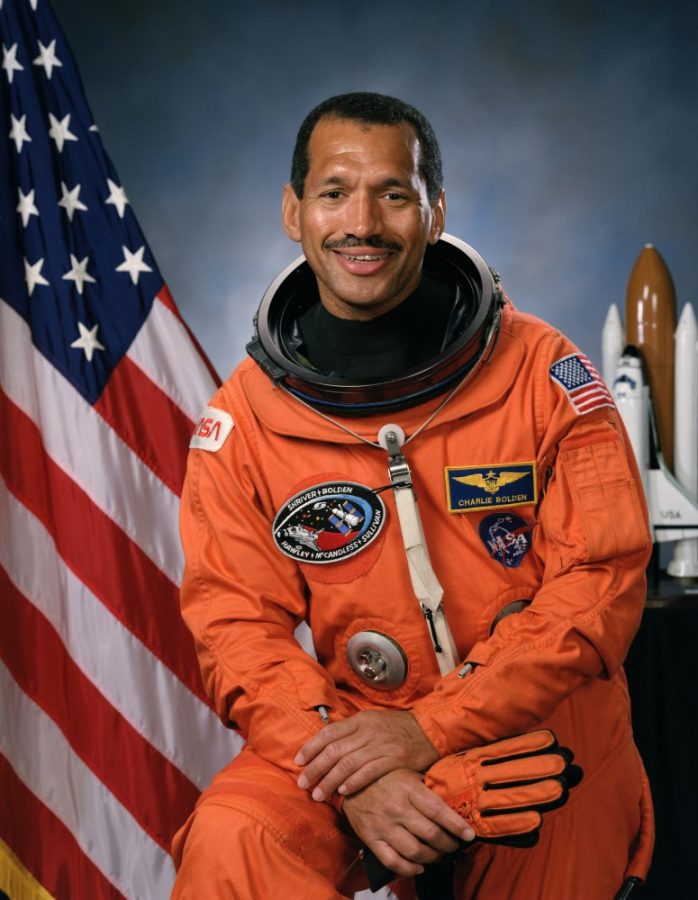Former National Aeronautics and Space Administrations administrator Maj. Gen. Charles Frank Bolden Jr. will be the UA’s commencement speaker this May.
According to an email from UA President Ann Weaver Hart, aside from the contributions that he has made to the OSIRIS-REx launch in September, Bolden has worked as a naval aviator and spent 34 years with the U.S. Marine Corps.
As an innovative leader, Bolden contributed to NASA’s development into a new age of space exploration, which included “decisions to retire the Space Shuttle, enhance public-private partnerships in launches and develop the tools to put humans on Mars,” according to Hart’s email.
Surprisingly, Bolden initially never conceived of working at NASA as a goal, and after high school he had no plans to become an astronaut.
“There were two things I knew I wouldn’t do: I didn’t want to join the Marine Corps, and I was never going to fly,” Bolden said.
RELATED: OSIRIS-REx to search for Trojan Asteroids
After graduating high school, Bolden began defying both notions by receiving an appointment with the U.S. Naval Academy, which he had first seen on TV. Afterward, he became commissioned as a second lieutenant in the Marine Corps and mentored over 200 officers in his company.
Bolden said he saw Challenger astronaut Ronald McNair as a role model in his life and a deciding factor in why he chose to pursue a career with NASA. According to Bolden, they both grew up in the ‘50s and ‘60s with only a four-year age gap between them.
The NASA space shuttle astronaut encouraged Bolden to complete flight training school to become a naval aviator, which he did in 1970.
When they talked and McNair saw that he was interested, he asked if Bolden would do it.
Bolden said even when he said no McNair picked up a pen and paper and made him sign up for an interview.
Flying, which Bolden had initially seen as an inherently dangerous and crazy idea, became one of his largest passions.
“Once I began flying, I became convinced that this was something challenging and enjoyable,” he said.
Throughout his career, Bolden has loved everything, especially his time within the Marine Corps. “I spent three to four years being around marines and functioned as the one percent of the American public defending the nation,” Bolden said.
Within NASA, Bolden worked as administrator during the Obama administration and facilitated evolution within NASA’s programs, creating a broad portfolio that included “fostering a journey to Mars, advancing aviation with new aeronautic advances and taking care of our planet and people.”
As NASA’s administrator, Bolden worked with the Executive Office of the President, press and Congress to convince people in the White House and Congress to fund programs.
Human spaceflight is entering a new era utilizing the airspace industry and academia to create “cleaner, quieter and more efficient spaceflight,” according to Bolden.
Bolden said that he expects five new planes to be released in the next 10 years that will introduce science to a new realm of space flight.
Bolden hopes one plane will change the way supersonic flight is restricted on airplanes by using acoustic energy to surpass the speed of sound with the only after-effect being a mild rumble.
RELATED: NASA reveals nearby planets that could support life

A plane with that much power could fly large distances in a drastically short amount of time, such as from Singapore to New York in less than five hours.
Another plane may use solar energy to power a configured electric engine.
With a new wide-body concept, Bolden said that, although it may look like a roll of paper towels, the plane will cut down on consumption, noise and pollution by 50 to 60 percent.
In coordination with the UA, NASA launched OSIRIS-REx to collect a sample of the asteroid Bennu and return it to Earth, which Bolden described as “awesome.”
Bolden said it is “mind-boggling that a satellite flying for months can reach a target with such precision.”
He said he appreciates the committed people who worked on this mission and thinks this story, like a piece of science fiction, is making advancements in science possible.
OSIRIS-REx is expected to collect samples of the asteroid’s surface and return to Earth in the year 2023, landing somewhere in the Utah desert.
The next big collaboration between the UA and NASA will come when they create a high-wave gamma ray spectrometer, one of the many project that the UA has played a key role in facilitating with NASA.
The UA has had a long relationship with NASA and when Bolden was asked to be this year’s commencement speaker, he accepted immediately.
“[President Hart] became a champion of NASA,” Bolden said, primarily because of her efforts to promote diversity and inclusion on campus.
Bolden said he was impressed by Hart and her staff and is proud the UA is a partner of NASA because of its positive affiliations and impact.
“I could not have asked [to work with] more energetic people,” Bolden said regarding the OSIRIS-REx launch.
Although Bolden does not have a permanent speech planned out yet, he knows that caring for other people is of critical importance to him.
Bolden learned from a young age that taking care of others is the key to success.
“If you can’t take care of other people, take care of yourself,” he said, and expand your horizons to learn and gain new opportunities.
Parents are a large part of this goal to become a more diverse and exceptional student body, as they inspire belief that “we can do what we do” and give students the opportunity to do whatever they want.
Bolden is proud to see that the UA is an expanding, innovative university that encourages diversity within its students. He said he looks forward to delivering his commencement speech.
This year, the UA commencement ceremony will begin Friday, May 12, at the Arizona Stadium at 7:30 p.m.
Follow Elizabeth Quinlan on Twitter.









